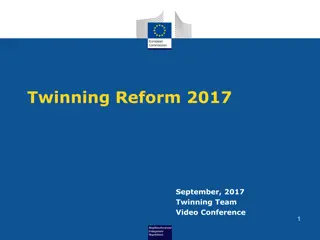
Unraveling Metric Pitfalls in Online Controlled Experiments
Dive into the complexities of online controlled experiments with Ron Kohavi from Microsoft as he sheds light on common metric interpretation pitfalls and the importance of session metrics for platforms like Bing. Discover key insights on optimizing user sessions for improved performance and success rates.
Download Presentation

Please find below an Image/Link to download the presentation.
The content on the website is provided AS IS for your information and personal use only. It may not be sold, licensed, or shared on other websites without obtaining consent from the author. If you encounter any issues during the download, it is possible that the publisher has removed the file from their server.
You are allowed to download the files provided on this website for personal or commercial use, subject to the condition that they are used lawfully. All files are the property of their respective owners.
The content on the website is provided AS IS for your information and personal use only. It may not be sold, licensed, or shared on other websites without obtaining consent from the author.
E N D
Presentation Transcript
Oct 27-28, 2017 Metric Pitfalls in Online Controlled Experiments Metric Pitfalls in Online Controlled Experiments Slides at https://bit.ly/CODE2017Kohavi Ron Kohavi, Distinguished Engineer, General Manager, Analysis and Experimentation, Microsoft Based on KDD 2017 paper by Pavel Dmitriev, Somit Gupta, Dong Woo Kim, and Garnet Vaz A Dirty Dozen: Twelve Common Metric Interpretation Pitfalls in Online Controlled Experiments
About the Team Analysis and Experimentation team at Microsoft: Mission: Accelerate innovation through trustworthy analysis and experimentation. Empower the HiPPO (Highest Paid Person s Opinion) with data About 90 people, software developers, data scientists, and PMs We initially built the system for Bing, where about 1,200 controlled experiment treatments now run every month, with millions of users each Last 3+ years, generalizing the system to a Microsoft-wide platform Platform in growing use at MSN, Office, OneNote, Xbox, Cortana, Skype, Outlook, Exchange, Windows, Edge browser, Web store, and more Summary at HBR article last month (with Thomke): http://bitly.com/HBR_AB Pitfalls discussed are from diverse groups at Microsoft 2 Ronny Kohavi
Background: Session Metrics for Bing Why session metrics are important for us(*) Search engines (Bing, Google) are evaluated on query share (distinct queries) and revenue as long-term goals Key Example A ranking bug in an experiment resulted in very poor search results Queries per user improved by 10% (hence query share is going up). Why? People had to reformulate queries several times Revenue went up over 30% (we re making a lot more money!). Why? Ads (not impacted by the bug) became relatively more useful We fired the relevance team, and Bing s US PC query share is up from 8% in 2009 to 23% in 2017, and is now profitable (*) KDD 2012 Paper: Trustworthy Online Controlled Experiments: Five Puzzling Outcomes Explained 3 Ronny Kohavi
Key Insight: Sessions are Critical Decompose queries per month as follows: ??????? ???? =??????? ??????? ???????? ????? ???? ???? Key observation: we want users to find answers and complete tasks quickly, so queries/session should be minimized Sessions/user should be maximized. This is very appealing: repeat usage. The holy grail. A controlled experiment, the variants get (approximately) the same number of users by design, so the last term is about equal We have multiple metrics around sessions (queries/session, time to success, success as Boolean, etc) 4 Ronny Kohavi
Pitfall #1 (a trivial observation really) If the Sessions/user metric changes, session-level metrics may be invalid Example: suppose we sessionize by 20 minutes of inactivity in treatment instead of 30 minutes in control Empirically, Sessions/user is a REALLY hard metric to improve, so this rarely matters. In CODE 2015, I mentioned that two out of 10K experiments improve this metric If Pages/user metric changes, then all click-through metrics may be invalid Example: MSN implemented auto-refresh of the home page every few minutes. Fresh news due to refresh is good for the users, but click-through rate is much much much lower Detection: if the denominator changes between control and treatment for ratio metrics like click-through rates, it invalidates the ratio metrics 5 Ronny Kohavi
Puzzling Result: Opening Links in New Tab In 2009 paper: opening Hotmail/Outlook.com link in a new tab at MSN showed significant benefits Recent experiment opened news articles in new tab Surprising result: 8% increase (degradation) in page load time (measured at 75th percentile) Why? Similar to Clickthrough rate issue on prior slide, but less obvious Fewer pages in treatment (8.4M vs. 9.2M) Control: users hit back button to go back from news to home page, which refreshes Treatment: there is no back button. Users kill the tab and see the previous tab with home page Reloading the home page is faster than average page due to caching effects (e.g., images cached), and treatment has fewer of these loads, so it looks slower by metrics (it s actually faster!) 6 Ronny Kohavi
Pitfall #2: Heterogenous Treatment Effects The hot topic in last year s CODE, many speakers (including me) mentioned that this is important and we ve implemented algorithms to detect these Puzzling experiment Two segments showed a stat-sig, positive, treatment effect to sessions/user. A huge cause for celebration, as such movements are very rare. These were complementary segments: mutually exclusive and exhaustive, and the treatment helped users in both segments. Wow! But the overall average treatment effect for sessions/user was basically zero: far from stat-sig What s going on? 7 Ronny Kohavi
Pitfall #1 Famous story (hypothetical, no political motives): When President X ended his presidency and went from Washington DC back to his home state, the average IQ in both DC and his home state went up Nothing wrong here. It s definitely possible. Variant of Simpson s paradox. His IQ has to be lower than the average in DC, and higher than in his home state. Remove a below-average-IQ person in DC, and the average goes up. Add an above-average-IQ person to the home-state, and it also goes up In our experiment, users shifted from one segment to another Prevention: don t allow segments that could be impacted by treatment (too restrictive for us) Detection: alert if there is a ratio mismatch 8 Ronny Kohavi
The App Store Rating Trick A variant of this is now commonly used by mobile apps to improve their app-store rating Think of three segments 1. Users that rate the app high (4-5 stars) 2. Users that rate the app low (1-3 stars) 3. Users that don t rate the app What if instead of improving the product (really hard), you could just shift users from #2 to #3? It turns out it s pretty easy. Ask a question that correlates with high rating, such as Enjoying <product>? 9 Ronny Kohavi
Pitfall #3: Ignoring Twymans Law Experiment changed Outlook.com link (left) to Mail app Result: 28% increase in the number of clicks on the button. Even better: 27% increase in the number of clicks on the button adjacent to the mail button. Celebrate? NO! Remember Twyman Twyman s Law: Any figure that looks interesting or different is usually wrong 10 Ronny Kohavi
Pitfall #3 (continued) Graph over time showed dramatically diminishing delta Users were confused, repeatedly clicked on icon and nearby icon. They were expecting outlook web site, and the mail app popped up. Learned not to click: Proportion of users clicking on the whole stripe was down Lesson: We are biased to celebrate good results and investigate bad results Remember Twyman s law, especially if results look Too-Good-To-Be-True 11 Ronny Kohavi
Summary KDD 2017 paper by Pavel Dmitriev, Somit Gupta, Dong Woo Kim, and Garnet Vaz A Dirty Dozen: Twelve Common Metric Interpretation Pitfalls in Online Controlled Experiments Experimentation systems should be able to detect common pitfalls and alert the experimenters Dirty Dozen: 1. Metric Sample Ratio Mismatch 2. Misinterpretation of Ratio Metrics Best experimenters have healthy skepticism Triangulate a result through multiple data points Have good hypotheses about why metrics are moving and show support by diagnostic metrics Apply Twyman s law Drill down into segments 3. Telemetry Loss Bias 4. Assuming Underpowered Metrics had no Change 5. Claiming Success with a Borderline P value 6. Continuous Monitoring and Early Stopping 7. Assuming the Metric Movement is Homogeneous 8. Segment Interpretation 9. Impact of Outliers Slides at https://bit.ly/CODE2017Kohavi 10. Novelty and Primacy Effects 11. Incomplete Funnel Metrics 12 Ronny Kohavi 12. Failure to Apply Twyman s Law
Appendix 13 Ronny Kohavi
Background: Observations to Metrics You ran a controlled experiments (e.g., A/B test) and collected observations: page views, clicks, hovers, revenue events, add-to-cart, initiate checkout, submit, timers (e.g., server start/end, time element displayed, click time) Calculated / enriched observations Time to X (e.g., time to display key elements, server time to send HTML) Successful click (in search engines, user clicks and does not come back within 30 seconds) Session end (no user activity for at least 30 minutes) Observations are aggregated to metrics at different levels: User, Session, Page User metrics: Page views/user, clicks/user, revenue/user, average page load time/user Session metrics: successful session (has successful click), time to success (capped), page views per session Page metrics: click-through rate, RPM (revenue per thousand impressions) 14 Ronny Kohavi
Double Aggregation to User Level We usually provide user-level metrics by aggregating metrics at lower levels Time to session success/user: average (over user sessions) of time to success Session success rate/user: average of (over user sessions) of successful session (a Boolean) Reasons for double aggregation More robust: bots with thousands of sessions do not skew metric (each user is weighted the same in the 2nd-level average) Users are (mostly) independent, so statistics are easy. For non-user metrics, we use delta-method and bootstrap. In practice, many metrics are computed two ways: Single aggregation (e.g., average of page metric or session metric). E.g., (total clicks) / (total pages) Double aggregation. E.g., ?=1 ????? ??? ????_? We highlight if the two computations diverge. The double aggregation tends to be more useful in practice due to robustness ?????? ??? ????_? ? 15 Ronny Kohavi









